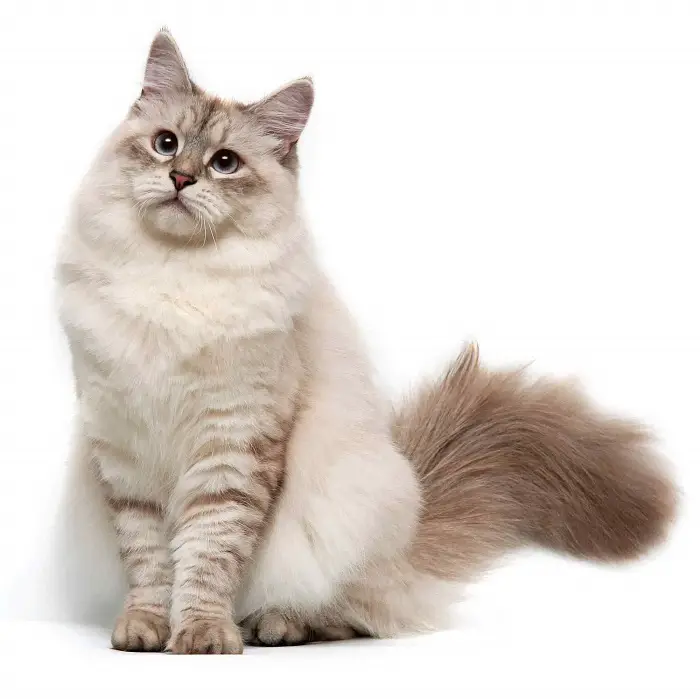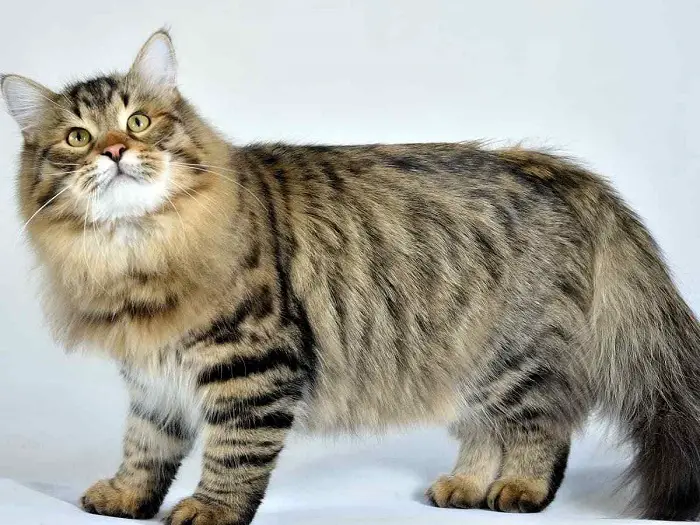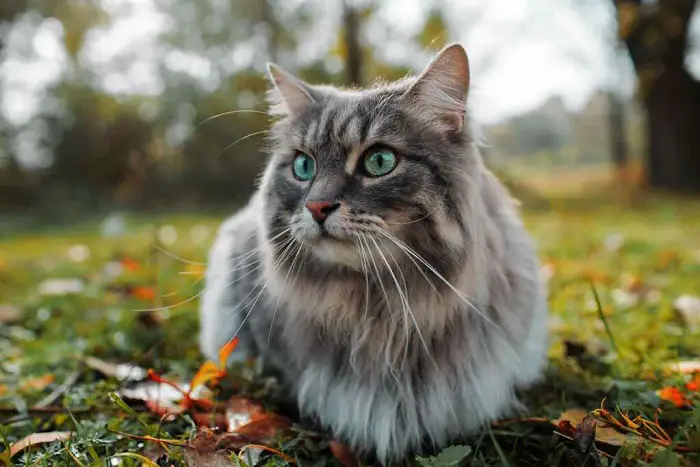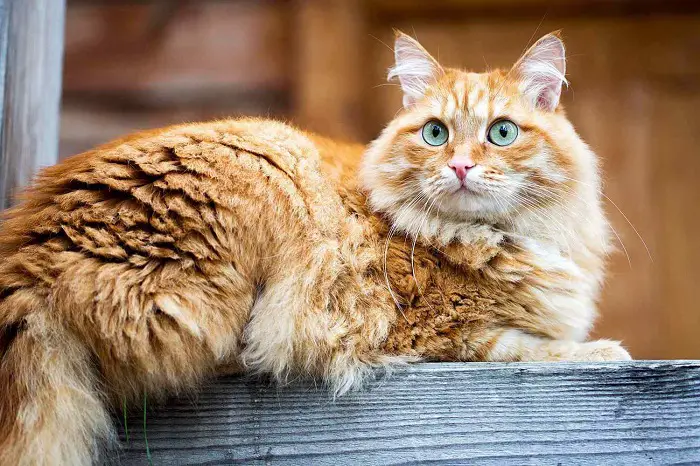Siberian cats, also known as Moscow Longhairs, are domestic cats that originated in Russia. They are known for their striking appearance, muscular build, and thick, luxurious fur. Siberian cats make excellent pets for people willing to give them the attention and care they need, including regular grooming and playtime. Suppose you’re considering bringing a Siberian cat into your home. In that case, it’s important to research breeders carefully and ensure you get your cat from a reliable source that prioritizes the health and well-being of their cats.
History and Origin of Siberian Cat
The Siberian cat’s history and origin can be traced back to Russia, which has a long and storied history as a natural breed. While the exact origins of the Siberian cat have yet to be well documented, they are believed to have evolved over centuries in the Siberian region of Russia. Here’s a brief overview of their history and origin:
Natural Development: Siberian cats are considered a naturally occurring breed, which means they evolved in their native environment without significant human intervention in selective breeding. They adapted to Siberia’s harsh climates, characterized by cold winters and a challenging environment.
Working Cats: Siberian cats were traditionally kept on farms, villages, and homes throughout Siberia. They served as valuable working cats, helping control rodent populations and other pests. Their thick fur, muscular build, and hunting skills made them well-suited to these tasks.
Historical References: There are historical references to cats resembling the Siberian breed dating back centuries in Russian literature and folklore. These references suggest that the breed has been present in Russia for a long time.
Influence of Other Breeds: While Siberian cats were primarily developed naturally, it’s possible that they interbred with other cats brought to Russia by traders and explorers over the centuries. Some experts believe the Siberian breed may have some genetic influence from other breeds like the Norwegian Forest Cat.
Recognition and Preservation: The Siberian cat was officially recognized as a breed in Russia in the early 20th century. However, the breed’s formal recognition and preservation efforts were disrupted by the Russian Revolution and subsequent events in the early 20th century.
Introduction to the West: In the late 20th century, Siberian cats were introduced to Western countries, particularly the United States and Europe. Cat enthusiasts and breeders began importing Siberian cats and establishing breeding programs to preserve and promote the breed.
Physical Features of Siberian Cats
Siberian cats are known for their distinctive physical features, contributing to their unique and striking appearance. Here are some key physical features of Siberian cats:
Size: Siberian cats are medium to large-sized cats. Adult males typically weigh between 13 to 18 pounds (6 to 8 kilograms), while females usually weigh between 8 to 12 pounds (4 to 5.5 kilograms). Their robust build gives them a sturdy and muscular appearance.
Coat: The Siberian cat’s most notable feature is its luxurious, semi-longhaired coat. Their dense fur is designed to protect them from the cold Siberian winters. It has three layers: a soft, downy undercoat, a thicker middle layer, and a more extended guard hair outer layer. The coat can be substantial, especially during the winter months.
Fur Patterns and Colors: Siberian cats come in various coat colors and patterns. Standard colors include tabby, solid, bi-color, and colorpoint (like the Siamese pattern). Siberian cats can have various coat colors, including black, brown, blue, red, and more.
Fur Texture: Siberian cats have a soft, silky fur texture that is less prone to matting than other longhaired breeds. Their fur can have a glossy sheen, adding to their regal appearance.
Tail: Siberian cats have a long, bushy tail that tapers to a rounded tip. Their tail is well-furnished with fur, giving it a plume-like appearance.
Head Shape: Siberian cats have a broad, rounded head with a slightly convex profile. Their cheeks are complete, and their ears are medium to large, often adorned with tufts of hair at the tips. They have a strong jawline and a sweet facial expression.
Eyes: Siberian cats typically have large, expressive eyes in various colors, including green, gold, blue, or a combination. The eye color can differ depending on the coat color.
Body Structure: These cats have a well-balanced body with a straight back, strong legs, and round paws. Their overall physique is athletic and agile.
Hypoallergenic Qualities: Siberian cats are often considered hypoallergenic, though individual reactions to cat allergens can vary. Some people with cat allergies find that they tolerate Siberian cats better than other breeds, possibly due to their saliva and skin oils’ reduced Fel d 1 allergen levels.
Overall Impression: Siberian cats have a majestic and regal appearance with a wild, forest-like charm. Their thick fur, robust build, and expressive eyes appeal to cat enthusiasts.
Height, Weight, and Lifespan of Siberian Cats
Siberian cats are known for their unique characteristics. Here’s some information about their typical height, weight, and lifespan:
Height: Siberian cats are typically medium to large-sized cats. Their height at the shoulder, also known as the shoulder height, can range from 8 to 11 inches (20 to 28 centimeters) on average.
Weight: The weight of a Siberian cat can vary depending on factors like age, sex, genetics, and diet. Adult Siberian cats typically weigh between 8 and 17 pounds (3.6 to 7.7 kilograms), with males being larger and heavier than females.
Lifespan: The lifespan of a Siberian cat is influenced by various factors, including genetics, diet, healthcare, and living conditions. On average, Siberian cats have a lifespan of around 12 to 15 years. However, with proper care, some Siberian cats have been known to live into their late teens or even early twenties.
Colors of Siberian Cat
Siberian cats come in different colors and patterns. The Siberian cat breed has a wide range of coat colors and patterns, and these can include:
Traditional Colors:
Brown Tabby: This is the most common color for Siberian cats. They have a brown background with darker brown or black stripes and markings.
Black: Siberian cats can also be solid black.
Blue: Blue Siberian cats have a bluish-gray coat.
Cream: Cream-colored Siberians have a light, creamy coat.
Red: Red Siberian cats have vibrant reddish-orange coats.
Colorpoint Patterns: Siberian cats with colorpoint patterns have a lighter body color and darker points on their ears, faces, paws, and tails. The most well-known colorpoint pattern is the “Siamese” pattern.
Tortoiseshell and Calico:
Tortoiseshell: Tortoiseshell Siberian cats have a mix of two or more colors, typically black and orange, in a brindle-like pattern.
Calico: Calico Siberian cats have a white base with patches of two or more other colors, often black and orange.
Bi-Color: Siberian cats with bi-color patterns have a mainly white coat with color on their ears, face, and tail.
Silver and Golden Variations:
Silver: Some Siberian cats have a silver coat, which can give them a shimmering appearance.
Golden: Golden Siberian cats have a warm, golden hue to their coat.
Smoke and Shaded Patterns:
Smoke: Siberian cats with smoke patterns have a solid color at the root of their fur, gradually fading to a lighter color towards the tips.
Shaded: Shaded Siberian cats gradually transition from a darker color at the back to a lighter color on the sides and belly.
White and Odd-Eyed Siberian Cats: Some Siberian cats can be completely white, and some may even have odd-colored eyes, with one eye being a different color from the other.
Behavior and Temperament of Siberian Cats
Siberian cats are known for their distinctive behavior and temperament. They are generally known to be friendly, intelligent, and affectionate cats. Here are some critical aspects of their behavior and temperament:
Affectionate: Siberian cats are often described as affectionate and loving companions. They enjoy being around their human family members and are known to form strong bonds with them. They may follow you around the house, sit on your lap, and enjoy cuddling.
Playful: Siberian cats are playful and energetic. They enjoy interactive play and toys, so it’s a good idea to provide them with toys that stimulate their hunting instincts. Interactive playtime can help keep them mentally and physically engaged.
Intelligent: These cats can learn tricks and solve simple puzzles. They can be trained to do things like fetch or perform other tricks if you’re patient and use positive reinforcement training methods.
Social: Siberian cats are generally social and enjoy the company of people and other animals. They often get along well with children and other pets, making them a good choice for families.
Adventurous: Siberian cats are known for their curiosity and love of exploring their surroundings. They may enjoy outdoor activities if you have a safe and secure outdoor space, but many Siberian cat owners keep them indoors to protect them from potential dangers.
Vocal: While Siberian cats are not overly vocal, they can communicate and use soft meows and purring to express their needs or desires. They may “talk” to their owners from time to time.
Independent: While they enjoy human company, Siberian cats have an independent streak. They are not overly clingy and can entertain themselves when needed.
Adaptable: Siberian cats adapt well to new environments and routine changes, making them suitable for various living situations.
Protective: Some Siberian cats exhibit protective behaviors towards their families and may act as “watchcats,” alerting their owners to potential dangers or visitors.
Care and Management of Siberian Cats
Caring for Siberian cats involves providing them with proper nutrition, grooming, healthcare, and attention to their specific needs. Here are some essential aspects of caring for and managing Siberian cats:
- Nutrition: Feed your Siberian cat a portion of balanced and appropriate cat food. Consult with your veterinarian for recommendations on the type of food, portion sizes, and feeding schedule.
- Provide fresh water at all times to keep your cat well-hydrated.
- Grooming: Siberian cats have a thick double coat that requires regular grooming to prevent matting and reduce shedding. Brush your Siberian cat a few times a week and often during shedding seasons (spring and fall). Using a quality cat brush or comb can help remove loose fur. Pay extra attention to grooming during the shedding season to prevent excessive hairballs.
- Litter Box: Provide a clean and appropriately sized litter box for your Siberian cat. Scoop it daily and change the litter regularly. Siberian cats are typically good about using the litter box if kept clean.
- Exercise and Play: Ensure your Siberian cat gets regular exercise and mental stimulation. Interactive toys, play sessions, and cat trees can keep them engaged and active. Some Siberian cats enjoy outdoor adventures but ensure that they are in a safe and enclosed environment.
- Healthcare: Schedule regular check-ups with a vet to monitor your cat’s overall health and address any medical concerns. Keep up with vaccinations, flea and tick prevention, and dental care as your veterinarian recommends. Discuss spaying or neutering options with your veterinarian if your cat is not intended for breeding.
- Allergies: Siberian cats are often considered hypoallergenic, but it’s essential to note that individual reactions can vary. Spend time with a Siberian cat to see if you or your family are allergic before bringing one into your home.
- Socialization: Siberian cats are generally friendly, but early socialization is essential to help them get along with other pets and people. Introduce them to various experiences, people, and environments to build their confidence.
- Safety: Ensure your home is safe for your Siberian cat. Remove hazards, secure windows and balconies, and keep toxic substances out of their reach. Use safe and appropriate scratching posts to prevent damage to furniture.
- Affection and Attention: Siberian cats are known for their affectionate nature. Spend quality time with your cat, offering attention and affection. Create a loving and comfortable environment to make your cat feel secure.
- Training: Use basic obedience training techniques to teach your Siberian cat basic commands and behaviors. Reward your cats with good behavior with treats, praise, or playtime.
Food and Nutrition of Siberian Cat
Feeding your Siberian cat a balanced and nutritious diet is necessary for their health and well-being. Here are some guidelines for the food and nutrition of Siberian cats:
- High-Quality Cat Food: Choose a high-quality commercial cat food appropriate for your cat’s age, activity level, and any specific dietary requirements. Look for cat diets that contain a high-quality source of animal protein as the main ingredient. Cats are obligate carnivores, and protein is a crucial diet component.
- Wet vs. Dry Food: Many veterinarians recommend combining wet and dry cat food. Wet food can help keep your cat hydrated because of its higher moisture content, while dry food can assist with dental health. Some Siberian cat owners prefer to feed primarily or exclusively wet food due to its moisture content, as cats can be prone to urinary tract issues.
- Avoid Feeding Human Food: While sharing human food with your cat can be tempting, sticking to cat-specific foods is generally best.
- Special Dietary Considerations: If your Siberian cat has specific dietary requirements or food allergies, work with your veterinarian to select an appropriate diet that meets their needs.
- Consult with Your Veterinarian: Regular veterinary check-ups are crucial for monitoring your cat’s health and nutritional needs. Discuss your cat’s diet with your veterinarian to ensure it aligns with their well-being.
- Treats in Moderation: Treats can be given to your Siberian cat as an occasional reward but should not make up a significant portion of their daily caloric intake. Opt for cat-specific treats rather than human foods.
- Transitioning Foods: Suppose you gradually switch your Siberian cat’s diet over several days to avoid digestive upset. Mix the fresh food with the old food, gradually increasing the amount of the new food.
- Weight Management: Monitor your cat’s weight and body condition regularly. If you notice significant weight changes, consult your veterinarian to adjust your diet accordingly.
The Health of Siberian Cats
Like any other breed, the health of Siberian cats depends on various factors, including genetics, diet, exercise, grooming, and veterinary care. Siberian cats are considered a healthy breed but can be susceptible to specific health issues. Here are some common health considerations for Siberian cats:
- Hypertrophic Cardiomyopathy (HCM): This is a genetic heart condition that can affect Siberian cats, as well as other breeds. Regular veterinary check-ups can help monitor their heart health. Breeding Siberian cats should be done responsibly, with screening for HCM in the breeding population.
- Obesity in Cats: Overfeeding and lack of exercise can lead to obesity in Siberian cats. Obesity can contribute to various health problems, including diabetes, arthritis, and heart issues. Monitor your cat’s weight and provide them with balanced food and regular exercise to maintain a healthy weight.
- Urinary Tract Issues: Some Siberian cats may be vulnerable to urinary tract issues, such as infections or crystals. Providing ample fresh water and a diet that supports urinary health can help prevent these problems.
- Allergies: While Siberian cats are often considered hypoallergenic, meaning they may produce fewer allergenic proteins, individual reactions can vary. Some people with allergies may still react to Siberian cats. Spend time with a Siberian cat before bringing one into your home if allergies concern you.
- Dental Health: Dental issues can affect cats of any breed. Brush your Siberian cat’s teeth regularly or provide dental treats and toys to help maintain oral health.
- Parasites: Like all cats, Siberian cats can be affected by external parasites such as fleas and ticks and internal parasites like worms. Keep your cat on a regular parasite prevention program recommended by your veterinarian.
Concluding Remarks on Siberian Cat
In conclusion, Siberian cats are a remarkable and captivating breed known for their unique qualities and characteristics. They have a rich history, hailing from the Siberian region of Russia, and have become cherished companions worldwide.
Before bringing a Siberian cat into your home, it’s essential to research the breed thoroughly, consider their unique needs, and ensure that their temperament aligns with your lifestyle. Siberian cats can make excellent companions for families and individuals who appreciate their unique qualities and are willing to provide them with the love, care, and attention they deserve.



